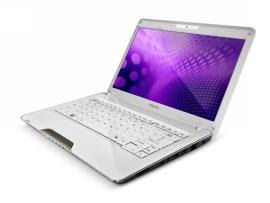 With the anticipated launch of Windows 7, we are seeing a ton of new laptops coming out that already have Windows 7 integrated into them. Toshiba has just launched a new line of slim laptops entitled the T100 series. Toshiba has unveiled two new laptops for the T100 series, the 13.5-inch T135 and the 11.6-inch T115. Each device is less than one inch thick with multi-touch touchpads and LED backlight displays.
With the anticipated launch of Windows 7, we are seeing a ton of new laptops coming out that already have Windows 7 integrated into them. Toshiba has just launched a new line of slim laptops entitled the T100 series. Toshiba has unveiled two new laptops for the T100 series, the 13.5-inch T135 and the 11.6-inch T115. Each device is less than one inch thick with multi-touch touchpads and LED backlight displays. One new feature included in the T100 series, as well as most of the recent Toshiba laptops, is the extremely useful sleep-and-charge feature. The sleep-and-charge feature lets you connect an iPod or other device to the USB port to allow you to charge them even if the system is in sleep mode or off.
These two devices have some nice specs about them. The T115 comes with your choice
 of an Intel Pentium processor SU4100 or Intel Celeron processor 7435 and a starting 250GB (5400 RPM) HDD7 disk with up to 4GB of memory. The T115 also has Windows 7 Home Premium OS, eSATA/USB combo port with USB Sleep-and-Charge, 1 HDMI port, built-in webcam with Toshiba Face Recognition, stereo speakers, microphone, 5-in-1 memory card reader slot, Toshiba Hard Drive Impact sensor, 802.11 b/g/n wireless 8 10/100 Ethernet, a 6-cell battery with up to 9hrs of charge and an 11.6-inch diagonal widescreen HD TruBrite LED Backlit display. All of this comes in at around $450.
of an Intel Pentium processor SU4100 or Intel Celeron processor 7435 and a starting 250GB (5400 RPM) HDD7 disk with up to 4GB of memory. The T115 also has Windows 7 Home Premium OS, eSATA/USB combo port with USB Sleep-and-Charge, 1 HDMI port, built-in webcam with Toshiba Face Recognition, stereo speakers, microphone, 5-in-1 memory card reader slot, Toshiba Hard Drive Impact sensor, 802.11 b/g/n wireless 8 10/100 Ethernet, a 6-cell battery with up to 9hrs of charge and an 11.6-inch diagonal widescreen HD TruBrite LED Backlit display. All of this comes in at around $450.The T135 comes with your choice of an Intel Pentium SU4100 processor or Intel
 Pentium SU2700 and a starting 250GB (5400 RPM) HDD disk with up to 8GB of memory. The T135 also has Windows 7 Home Premium OS, eSATA/USB combo port with USB Sleep-and-Charge, 1 HDMI port, built-in webcam with Toshiba Face Recognition, stereo speakers, microphone, 5-in-1 memory card reader slot, Toshiba Hard Drive Impact, 802.11 b/g/n wireless and 10/100 Ethernet, a 6-cell battery with up to 9hrs of charge and a 13.3-inch diagonal widescreen HD TruBrite LED Backlit display. The T135 is a little more expensive than the T115 coming in at around $600.
Pentium SU2700 and a starting 250GB (5400 RPM) HDD disk with up to 8GB of memory. The T135 also has Windows 7 Home Premium OS, eSATA/USB combo port with USB Sleep-and-Charge, 1 HDMI port, built-in webcam with Toshiba Face Recognition, stereo speakers, microphone, 5-in-1 memory card reader slot, Toshiba Hard Drive Impact, 802.11 b/g/n wireless and 10/100 Ethernet, a 6-cell battery with up to 9hrs of charge and a 13.3-inch diagonal widescreen HD TruBrite LED Backlit display. The T135 is a little more expensive than the T115 coming in at around $600. With the release of Windows 7 growing ever nearer, we can expect most laptops coming out in the future to be equipped with Windows 7 and if Windows 7 delivers even some of what it promises then we can all be excited. You can pick up both the T115 and the T135 on October 22, 2009.



